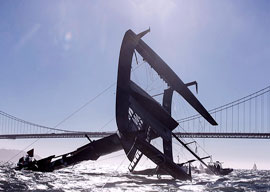
September 11, 2013

Seven score and twenty-something years ago, a boat crossed the Atlantic from Hoboken, New Jersey for a day sail around the Isle of Wight. Thirty proper yachts vied with the sharp pilot schooner America at the start of the All Nations Race, but not one boat was left in sight when she finished to win the 100 guineas worth of bad Victorian silver that symbolized American nautical supremacy for a century thereafter.
Sports history’s longest winning streak did not come easy. It kept the New York Yacht Club’s naval architects and sea lawyers busy adding speed to boats and chicanery to the rule book for six generations, driving yacht design relentlessly forward as the rest of the world sought to take away the object of ever growing desire that stood bolted on the wall in a niche at the clubhouse on 44th Street.
Beating off the European challenges for the Cup began soon after the Civil War ended, leading to technological feats of bizarre precocity. A decade before aluminum framed the first zeppelin, the newfangled metal formed the hull of the equally enormous sloop Defender. The escalation culminated in designs that fit form and function so flawlessly, they flowed into art. The only vessels arguably more beautiful than the J-class boats that challenged and defended in the years between the World Wars are the small but perfect 12-meter yachts that extended the NYYC winning streak to 22 consecutive victories by 1980. It wasn”t even close. So fierce was the competition to defend the Cup that even in the depths of the Depression, one New York syndicate recruited a mad keen Princeton sailor named Einstein to its Tuxedo Park brain trust, only to have their boat, Whirlwind, come in second.
Yet for all the competition, the Cup remained a decidedly amateur sport whose postwar revival saw one family commission and crew a wooden 12-meter in which they avidly competed for the right to defend the Cup. Easterner still sails, and occasionally wins, in classic boat races up and down the East Coast, but all good things must come to an end. As the 12-meter boats pushed the envelope of hydrodynamic perfection, their performance stalled. Single-hulled sailboats, never rattlingly fast to begin with, suddenly began to look a lot slower when surfboards and Hobie Cats entered our coastal culture.
The exhilarating speed of multihulls gave rise to a whole new sport, as high-speed multihull races and raids won a following in France. Transatlantic and “round-the-world sailing records were mowed down by the ever faster multihulls. This level of design innovation soon melded with computer science in Australia and elsewhere, and the summer of 1983 finally witnessed an inevitable confrontation in Newport”on their fourth try, the Australians came up with a 12-meter perceptibly faster than any American design and a pitch-perfect crew to sail her. Neither the tactical genius of Dennis Connor nor the weather wizardry of Halsey Herreshoff, the grandson of Defender‘s designer, could stave off the inevitable. They won three races in their slower boat, but the Australians won four with their faster one.